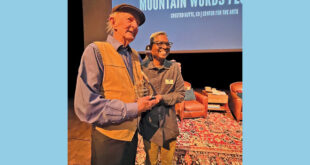by Brooke Harless MacMillan
As the sun streamed through the windows of the Crested Butte Community School (CBCS) STEM Lab on May 31, fifth grade students were hard at work trying to give an old dog a new leg.
For two months, the entire grade worked with the Denver-based 3D Printing Store and their non-profit arm, Pawsthetics, to draw and design a prosthesis for Walter, a dog-fighting bait dog that lost part of his front left leg in an illegal dog fighting match.
Walter, you’ll be glad to know, has since been rescued, has undergone several surgeries and is happily rehabbing. The Pawsthetics team has been working to develop several artificial leg devices for Walter but has yet to come up with one that works well for his unique needs.
CBCS students took a crack at the challenge during the last two months of school, drawing and designing prototypes for a prosthesis versatile and functional enough to get Walter back in action. Led by elementary STEM teacher Keely Moran, students first sketched their designs before building them in computer-aided design programs, CAD and Tinkercad. This was a brand new opportunity for students this year thanks to CBCS parent Rob Harper, who has worked with the 3D Printing Store in the past and pitched the idea of students learning design to the school. Moran jumped at the opportunity to teach students how to learn and use technology for good.
“What I’m really excited about is teaching the kids how to do things that benefit all. Using technology and design for humanity, and that impacts someone’s life in a positive way. Not just as an opportunity to make toys,” said Moran.
The kids did get to start off the project designing their own custom keychains; many used their names, while others went with the super popular phrase “Yeet,” which I’ll admit, I had to look up—it’s a dance move and an expression of glee.
The team from the 3D Printing Store—Justin Finesilver, Debra Wilcox, Nick Aguero and Brian Smith—have begun using Walter’s project as a custom curriculum unit for classrooms to learn about design and problem solving for real world application and has done similar projects with classrooms in Philadelphia and Georgia.
Finesilver started the session by show-and-telling some of the team’s most fun designs, which included a giant floppy Twizzler used in commercials, a crazy detailed blue dragon and colorful lampshades.
Designing and printing solutions to complex problems is the team’s main goal and they’ve successfully fit migratory birds with lightweight tracking devices, have made prosthetic devices for dozens of animals (mostly dogs, though they’ve also designed and printed a new shell for a turtle using ABS plastic, a material very common in automobile parts) and have printed satellite parts and testing materials used in the Antarctic.
When I visited the computer lab, hand-drawn Walter designs papered the desks as students worked with the visiting team to fine-tune their ideas in Tinkercad. The subtle hum of a large 3D printer (a Lulzbot Taz 5, made in Colorado) lent a soothing hum as it printed something purple. One student sat watching and without looking up mumbled to herself, “It’s so mesmerizing.”
The magic of three-dimensional printing works by basically turning a whole object into thousands of tiny little slices, then building it from the bottom-up, slice by slice. Eventually, after hundreds or even thousands of layers are stacked on top of each other, the result is a three-dimensional object. 3D printer technology is so good that each layer can now be very complex and can include moving parts like hinges and wheels as part of the same object; in Walter’s case, a customized appendage. Recently a company printed a working car, and scientists are busy working out how to print functioning biological organs using biomaterials.
Spirit Lockard, a student who took quickly to the project, showed me her design and mimed with her arm how it would work for Walter, explaining that each section needed to have a range of motion in order for it to suit his needs. Lockard, who is 12, was planning to go into mycology, the study of fungi, but the Walter project has given her pause. “My dad has always wanted me to go into computer programming, and at first I was like, ‘No way,’ but now I may ask him for some design programs.”
And now that the PTA has helped in purchasing the 3D printer used in the demonstrations, students will have the opportunity to continue to hone their design and printing skills.
While Walter is undergoing another round of therapy, Finesilver and his team are perfecting the next design for him to try out. They hope that through their work with students they may discover the missing link in making their prototype complete.
“We left our time at CBCS completely overwhelmed by how much thought the students gave to the project. Their designs were not only appropriate, they were well laid out and many were very feasible,” he said. “We’re very excited to have added another 80 or so experts to our Pawsthetics cause!”
 The Crested Butte News Serving the Gunnison Valley since 1999
The Crested Butte News Serving the Gunnison Valley since 1999




